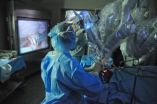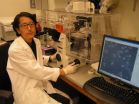Low-income neighborhoods experience far more injuries than high-income areas
Study in Journal of the American College of Surgeons found people living in low-income neighborhoods have nearly 20 times more penetrating injuries than people living in high-income neighborhoods
2010-09-07
(Press-News.org) CHICAGO (September 7, 2010) – Penetrating injury rates were more than 20 times higher for persons living in the lowest income neighborhoods compared with those living in the highest income neighborhoods, according to a new study published in the August issue of the Journal of the American College of Surgeons. Researchers also found that those in the lowest-income neighborhoods experienced nearly six times higher rates of blunt injury than persons in the highest income neighborhoods. Penetrating injuries included those from firearms or cuts; blunt injuries included motor vehicle crashes, falls and assaults.
Geographic variations in health have been a concern for researchers for many years. Previous research indicates that there is a clear association between living in a poor neighborhood and suffering from high rates of injury of various types. Furthermore, numerous reports indicate that there is an association between living in a socioeconomically disadvantaged neighborhood and poor health outcomes.
"These findings support the need to focus interventions to reduce injury rates in neighborhoods with the lowest socioeconomic status," said Ben L. Zarzaur, MD, MPH, FACS, assistant professor at the University of Tennessee Health Science Center in Memphis, Tenn. "Besides ensuring that all patients have access to the appropriate level of trauma care, we need to find ways to prevent those injuries in the first place."
Researchers evaluated 17,658 patients ages 18 to 84 who were admitted after injury to the Elvis Presley Memorial Trauma Center (EPMTC) from Jan. 1, 1996 to Dec. 31, 2005. EPMTC is a Level I trauma center at the Regional Medical Center in Memphis, and serves Tennessee, Mississippi and Arkansas. [Level 1 means it has a full range of specialists and equipment available 24-hours a day.] Addresses of adults admitted to EPMTC in the county from 1996 to 2005 were geocoded and matched to one of 214 census tract groups. The researchers divided census tract groups into quintiles based on percent of the population living below the poverty level (lowest to highest income neighborhood socioeconomic status (N-SES)). The five N-SES categories were: lowest (>34.8 percent of the population living below the poverty line); low-middle (20.9 to 34.8 percent of the population living below the poverty line); middle (10.0 to 20.8 percent of the population living below the poverty line); high-middle (4.4 to 9.9 percent of the population living below the poverty line); and highest (≤4.3 percent of the population living below the poverty line).
Crude injury admission rate ratios were calculated by N-SES category in Shelby County from 1996 to 2005 for blunt and penetrating injuries, with the highest N-SES category as the referent. Crude blunt injury rates steadily and significantly increased across N-SES categories to the point that persons living in the lowest N-SES category had nearly six times the crude blunt injury admission rate as those from the highest N-SES category. The results for injury admission rate ratios for penetrating injury were similar. Persons living in the lowest N-SES category in Shelby County had almost 21 times the rate of penetrating injury admission compared with those living in the highest N-SES category in Shelby County.
###
About the American College of Surgeons
The American College of Surgeons is a scientific and educational organization of surgeons that was founded in 1913 to raise the standards of surgical practice and to improve the care of the surgical patient. The College is dedicated to the ethical and competent practice of surgery. Its achievements have significantly influenced the course of scientific surgery in America and have established it as an important advocate for all surgical patients. The College has more than 77,000 members and is the largest organization of surgeons in the world. For more information, visit www.facs.org.
END
ELSE PRESS RELEASES FROM THIS DATE:
2010-09-07
Cow belches, a major source of greenhouse gases, could be decreased by an unusual feed supplement developed by a Penn State dairy scientist.
In a series of laboratory experiments and a live animal test, an oregano-based supplement not only decreased methane emissions in dairy cows by 40 percent, but also improved milk production, according to Alexander Hristov, an associate professor of dairy nutrition.
The natural methane-reduction supplement could lead to a cleaner environment and more productive dairy operations.
"Cattle are actually a major producer of methane ...
2010-09-07
VIDEO:
Tamer A. Ghanem, M.D., Ph.D., director of Head and Neck Oncology and Reconstructive Surgery Division in the Department of Otolaryngology -- Head & Neck Surgery at Henry Ford Hospital, discusses...
Click here for more information.
DETROIT – An incisionless robotic surgical procedure is offering patients a new option to remove certain head and neck cancer tumors without visible scarring, while preserving speech and the ability to eat.
Henry Ford Hospital in Detroit ...
2010-09-07
RIVERSIDE, Calif. – Human pluripotent stem (hPS) cells can generate any given cell type in the adult human body, which is why they are of interest to stem cell scientists working on finding therapies for spinal cord injuries, Parkinson's disease, burns, heart disease, diabetes, arthritis, and other ailments.
Before hPS cell technologies can be translated into clinical applications, however, some obstacles must first be overcome.
One such obstacle frustrating stem cell researchers is "cell death" that the major types of hPS cells, including human embryonic stem cells ...
2010-09-07
Plants cannot thrive without nutrients such as nitrogen, phosphorous or potassium, therefore farmers usually use organic and industrially manufactured mineral fertilizers to supply wheat, maize and others with these vital substances. In future, the need for nutrients will be soaring because we will only be able to supply the world's growing population with food and cover surging demands for biofuels by using fertilizers. Logically, that causes the prices for these nutrients to skyrocket. But that is not the only problem. The deposits of rock phosphates required for manufacturing ...
2010-09-07
A child who can't stop scratching himself may well be suffering from atopic dermatitis, also known as neurodermatitis. Extreme irritability of the skin with a concomitant urge to scratch is typical of the disorder. The condition often appears during the first year of life and is on the increase in industrialized countries. The patient's skin becomes hypersensitive and reacts strongly to even mild irritation. A research team led by Dr. Astrid Peters and Professor Katja Radon from Ludwig-Maximilians-Universitaet (LMU) in Munich has just published a longitudinal study which ...
2010-09-07
St. Louis, MO – Current research provides a novel model for rheumatoid arthritis research. The related report by LaBranche et al, "Characterization of the KRN cell transfer model of rheumatoid arthritis (KRN-CTM), a chronic yet synchronized version of the K/BxN mouse," appears in the September 2010 issue of The American Journal of Pathology.
Nearly 1% of the population is affected by rheumatoid arthritis, and women are affected three to five times more often then men. Although the course of disease varies greatly, daily living activities are impaired in most affected ...
2010-09-07
COLUMBIA, Mo. – With the fragmentation and globalization of the U.S. textile and apparel industry, business activities and roles have changed, impacting their organizational identity. The evolving organizational identity of these firms has created many questions as to how it affects the businesses financially. Now, a researcher at MU has explored how U.S. textile and apparel firms describe themselves as organizations and how those descriptions compare to U.S. Census Bureau industry classifications.Jung Ha-Brookshire, an assistant professor in the Textile and Apparel Management ...
2010-09-07
1. A Low-carb Diet Based on Animal Protein May Increase Death Risk
Evidence shows that a low-carbohydrate diet produces weight loss and improves some cardiovascular risk factors. However, health effects of a low-carbohydrate diet may depend on the type of protein and fat consumed. Researchers followed 85,168 women and 44,548 men on a low-carbohydrate diet for 26 and 20 years respectively. The patients ate either an animal-based (emphasizing animal sources of fat and protein) low-carbohydrate diet, or a vegetable-based low-carbohydrate diet. The researchers found that ...
2010-09-07
ST. PAUL, Minn. –A new study shows that mild cognitive impairment (MCI) may affect more men than women. The research is published in the September 7, 2010, print issue of Neurology®, the medical journal of the American Academy of Neurology.
Mild cognitive impairment is a condition in which people have problems with memory or thinking beyond that explained by the normal rate of aging. The study found that MCI was 1.5 times higher in men compared to women. MCI often leads to Alzheimer's disease.
"This is the first study conducted among community-dwelling persons to find ...
2010-09-07
ROCHESTER, Minn. -- A new Mayo Clinic study found that the prevalence of mild cognitive impairment was 1.5 times higher in men than in women. The research, part of the Mayo Clinic Study of Aging, also showed a prevalence rate of 16 percent in the population-based study of individuals aged 70-89 without dementia who live in Olmsted County, Minn. The study will be published in the September issue of Neurology.
"The finding that the frequency of mild cognitive impairment is greater in men was unexpected, since the frequency of Alzheimer's disease is actually greater in women. ...
LAST 30 PRESS RELEASES:
[Press-News.org] Low-income neighborhoods experience far more injuries than high-income areas
Study in Journal of the American College of Surgeons found people living in low-income neighborhoods have nearly 20 times more penetrating injuries than people living in high-income neighborhoods

